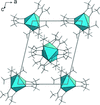issue contents
January 2020 issue

Cover illustration: A checkCIF validation report lists as ALERTS not only potential errors or unusual findings, but also suggestions for improvement along with interesting information on the structure at hand. ALERTS come mostly as short single-line messages. Major ALERTS for issues are expected to be acted on before submission for publication or discussed in the associated paper and/or commented on in the CIF file. The validation report can be obtained either using the IUCr web-based checkCIF server or a locally installed version of PLATON/checkCIF. As recommended by the author, it is good practice to run checkCIF frequently during the crystal-structure determination and when interpreting the structure itself. This way pitfalls such as missed symmetry and/or twinning can be avoided. This publication is a mine of information on what the checkCIF ALERTS mean and how authors should respond to them. It is the second publication in this journal related to a recent microsymposium entitled `Teaching new dogs old tricks' given at the 2019 ECM in Vienna. See: Spek [Acta Cryst. (2020). E71, 1-11].
research communications








































 journal menu
journal menu






































